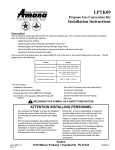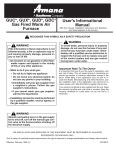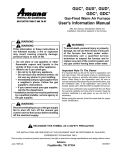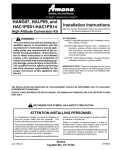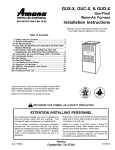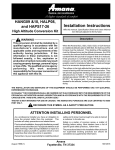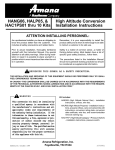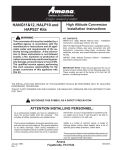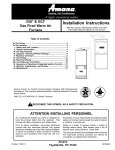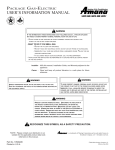Download Amana PGD**C Instruction manual
Transcript
LPTK07A Propane Gas Conversion Kit Installation Instructions ATTENTION INSTALLING PERSONNEL: As a professional installer you have an obligation to know the product better than the customer. This includes all safety precautions and related items. Remember, it is your responsibility to install the product safely and to know it well enough to be able to instruct a customer in its safe use. Prior to actual installation, thoroughly familiarize yourself with this Instruction Manual. Pay special attention to all safety warnings. Often during installation or repair it is possible to place yourself in a position which is more hazardous than when the unit is in operation. Safety is a matter of common sense...a matter of thinking before acting. Most dealers have a list of specific good safety practices...follow them. The precautions listed in this Installation Manual should not supersede existing practices but should be considered as supplemental information. RECOGNIZE THIS SYMBOL AS A SAFETY PRECAUTION. Description This kit is for the purpose of converting Amana Air Command 80 SSE, SV, 90 and 95 furnaces (GUIA, GUIB, GUIC, GCIA, GCIB, GCIC, GCC, GUC, GUD, GUX, GUIS, GCIS, GDC, and GCD) and Packaged Gas/Electric Units (PGB**C and PGD**C) from natural to propane gas. Any conversion to propane gas is the responsibility of, and at the risk of, the person making the conversion. WARNING AVERTISSEMENT PERSONAL INJURY HAZARD Cet ensemble de la conversion sera installé par une agence qualifiée dans accord avec les directives des fabricant et tous codes applicables et exigences de l'autorité ont la juridiction. Si les informations dans ces directives ne sont pas suivies exactement, un feu, explosion ou production de [monoxide] du carbone peut résulter cause propriété endommage, blessure personnelle ou perte de vie. La représentation de l'agence du service qualifiée ce travail suppose la responsabilité pour la conversion adéquate de cet appareil avec cet ensemble. This conversion kit shall be installed by a qualified agency in accordance with the manufacturers instructions and all applicable codes and requirements of the authority having jurisdiction. If the information in these instructions is not followed exactly, a fire, explosion or production of carbon monoxide may result causing property damage, personal injury or loss of life. The qualified service agency performing this work assumes responsibility for the proper conversion of this appliance with this kit. EFFECTIVE: June 1996 1 10308707 WARNING Installation CAUTION PERSONAL INJURY HAZARD To prevent death, personal injury or property damage due to fire or explosion caused by a propane gas leak, install a gas detecting warning device. Since rust can reduce the level of odorant in propane gas, a gas detecting warning device is the only reliable way to detect a propane gas leak. Contact a local propane gas supplier about installing a gas detecting warning device. PERSONAL INJURY HAZARD The gas supply must be shut off prior to disconnecting the electrical power, before proceeding with the conversion. 1. Remove the gas manifold by removing the burner box front cover (not required on all models), cutting the wire ties, disconnecting the gas valve low voltage wires, and removing the four manifold mounting screws. See Figure 1. IN CANADA THE CONVERSION SHALL BE CARRIED OUT IN ACCORDANCE WITH THE REQUIREMENTS OF THE PROVINCIAL AUTHORITIES HAVING JURISDICTION AND IN ACCORDANCE WITH THE REQUIREMENTS OF THE CAN/CGS B149.1 AND B149.2 INSTALLATION CODE. WARNING PERSONAL INJURY HAZARD To prevent death, serious personal injury or property damage due to fire or explosion caused by a propane gas leak, install a gas detecting warning device. Figure 1 Gas Manifold Removal 2. Replace natural gas orifices with the altitude appropriate propane orifices (Figure 2B) specified in Table 1. Tighten orifices with a box-end wrench. Do not use a socket wrench, as it could damage the orifices. Do not over-tighten. Do not cross thread. If the propane gas furnace is installed in a basement, an excavated area or a confined space, a warning device is required due to: Propane gas is heavier than air and any leaking gas can settle in any low areas or confined spaces. Propane gas odorant may fade, making the gas undetectable except with a warning device. If the presence of gas is suspected, follow these instructions: Do not try to light any appliance. Do not touch any electrical switch; do not use any phone in your building. Immediately call your gas supplier from a neighbors phone. Follow the gas suppliers instructions. If you cannot reach your gas supplier, call the fire department. This kit includes: installation instructions, propane orifices, valve conversion kits with instructions, conversion rating plate, conversion date certificate, wire ties, and screen/turbulator removal warning tag. Propane Gas Orifices Standard Altitude Data Model GUIA, GUIB GCIA, GCIB GUIC GCIC GUC, GUD GUX, GDC GCD, GCC PGB**C PGD**C GUIS, GCIS Kit Number High Altitude Data Orifice Altitude (ft) Pilot Orifice Kit Number Orifice Altitude (ft) LPTK07A #55 0 - 7500 N/A HALP06 #56 7500 - 11000 LPTK07A #55 0 - 6000 N/A HALP06 #56 6000 - 11000 LPTK07A #55 0 - 4500 N/A HALP08 #56 4500 - 9500 LPTK07A #55 0 - 6000 BBR12 HALP06 #56 6000 - 9500 LPTK07A #55 0 - 2000* N/A N/A N/A N/A * See the Amana Distributor for High Altitude Kits for installations above 2000 feet. Table 1 2 Figure 2A Replacing Gas Orifices Figure 4 Removal of Metal Screen Inserts a) Remove entire burner box assembly, including burners, from the partition panel as one unit. b) Hold assembly and remove the screen retention plate and tube inserts from each section of the heat exchanger. Figure 2B Propane Gas Orifices c) Reinstall the retention plate and entire burner box assembly. 5. Reinstall the gas manifold and reconnect the gas valve low voltage wiring. Install new wire ties making sure that wires do not droop between orifices and burners. NOTE: To prevent premature heat exchanger failure, follow the instructions below to remove all metal inserts from the heat exchanger tubes during propane conversions. 3. PGB**C and PGD**C models only: Remove pilot tube from gas valve. Remove the screws holding the pilot assembly to the burner tray and remove the assembly. Remove the pilot orifice as shown in Figure 3. Replace the pilot orifice with the orifice provided with the kit, and reassemble in reverse order. NOTE: To prevent unsatisfactory unit operation, the proper gas conversion kit must be used for each gas valve. Use the White-Rodgers kits only with the WhiteRodgers gas valve, and use the Honeywell Spring kit only with the Honeywell gas valve. THE SPRING KITS ARE NOT INTERCHANGEABLE. NOTE: Two stage furnaces do not require a spring kit. Discard all spring kits. 6. On single stage furnaces, replace the gas valve regulator spring with one of two new springs included in this propane conversion kit. If the unit is equipped with a White-Rodgers 36E (except 36E96) gas valve use Spring Kit #92-0659. If the unit is equipped with a Honeywell VR8205 or SV9500 gas valve use Spring Kit #393691-4. In each case, change the regulator spring per instructions included with that particular regulator spring. Discard unused spring kits. Orifice Figure 3 Package Unit Orifice WARNING 7. Leak check orifice threads using a soap solution. PERSONAL INJURY HAZARD WARNING All metal inserts, screens or turbulators must be removed from the heat exchanger tubes when using propane gas. Failure to comply could cause serious personal injury or death. Failure to comply with this requirement will also void warranty coverage. PERSONAL INJURY HAZARD To prevent death, personal injury or property damage due to fire or explosion, do not use a flame to check for leaks. 8. The position of the ignitor, relative to the burner, is not affected by this conversion procedure but the ignitor should be visually inspected for any damage at this point. Reinstall the burner box cover. 4. Remove metal screen inserts from the entrance of the heat exchanger tubes. See Figure 4 and follow the a,b,c directions. Some models do not have metal screen inserts. 3 11. On single stage units, set the manifold pressure to 10.0 W.C. (water column). For direct vent (GUD, GCD) furnaces, see Setting GUD and GCD Manifold Pressure before setting pressure (Figure 10). 9. Check inlet gas pressure. With the power and gas off, connect a water manometer or adequate gauge to the inlet pressure tap of the gas valve. With the power and gas on, put the unit into heating cycle and turn on all other gas consuming appliances. For propane gas the inlet gas pressure should be between 11.0 and 13.0 inches W.C. On two stage units, adjust the high stage manifold pressure to 10.0 W.C. and the low stage manifold pressure to 6.0 W.C. (Figure 7). The White Rodgers 36E96 gas valve requires a 3/32 allen wrench to adjust the manifold pressures. 10. Required input rating at standard altitude: Single Stage Units Input Ratings (Standard Altitude) Model A tapped opening is provided in the gas valve to facilitate measurement of the manifold pressure. A "U Tube manometer having a scale range from 0 to 12 inches of water column should be used for this measurement. The manifold pressure must be measured with the burners operating, and with the burner box cover (cover not used on all models) in place. Input BTU/HR GUIA, GUIB, GUIC, GCIA, GCIB, GCIC GCD, GDC PGB**C, PGD**C GUC, GUD, GUX, GCC GUIA, GUIB, GUIC, GCIA, GCIB, GCIC GCD, GDC PGB**C, PGD**C GUC, GUD, GUX, GCC GUIA, GUIB, GUIC, GCIA, GCIB, GCIC GCD, GDC PGB**C, PGD**C GUC, GUD, GUX, GCC GUIA, GUIB, GUIC, GCIA, GCIB, GCIC GCD, GDC GUC, GUD, GUX, GCC GUIA, GUIB, GUIC, GCIA, GCIB, GCIC 045 41,400 045 40,500 070 62,100 070 63,000 090 82,800 090 81,000 115 103,500 115 103,500 140 124,200 To adjust the pressure regulator, remove the adjustment screw or cover on the gas valve. Turn out (counterclockwise) to decrease pressure, turn in (clockwise) to increase pressure. Only small variations in gas flow should be made by means of the pressure regulator adjustment. In no case should the final manifold pressure vary more than plus or minus 0.3 inches water column from the specified pressure. Any major changes in flow should be made by changing the size of the burner orifices. 12. Verify the gas input rate by checking that the appropriate orifices have been installed and the manifold pressure has been set as stated in these instructions. 13. The burner flames should be stable, soft and blue (dust may cause orange tips but they must not be yellow). They should extend directly outward from the burners without curling, floating, or lifting off. Check unit temperature rise as described in the installation manual; temperature rise must be within the range shown on the furnace rating plate. Table 2 Two Stage Units Input Ratings (Standard Altitude) High Stage Low Stage Model Input BTU/Hr Input BTU/Hr GUIS, GCIS 70 62,100 48,000 GUIS, GCIS 90 82,800 64,000 GUIS 115 103,500 80,000 GUIS 140 124,200 96,000 14. Check the normal operating sequence of the ignition system to insure burners light properly. 15. Attach the label (found in the spring kit), indicating propane gas conversion, to the gas valve. 16. Attach conversion data plate, with correct input rating, adjacent to the unit rating plate. 17. Post conversion date certificate adjacent to the furnace. Table 3 Due to policy of continual product improvement, the right is reserved to change specifications and design without notice. 4 Main Solenoid WR Redundant Solenoid O F F INLET M 1 P 3 C 2 OUTLET ON Gas Contro Valve On/Off Selector Switch Outlet Pressure Tap (Side of Valve) Pressure Regulator Adjustment (Under Cap) Inlet Pressure Tap (Side of Valve) Figure 5 White Rodgers Model 36E22 or 36E23 Figure 8 Honeywell Model VR-8205 Outlet (Manifold) Pressure Tap Gas Control Lever Figure 6 White Rodgers Model 36E36 or 36E37 Outlet Inlet High Manifold Regulator Adjustment Screw (Under Cap) Inlet Pressure Tap (Side or Bottom) PM C HI Inlet Figure 9 Robertshaw Model 7222 Outlet OFF ON Inlet Pressure Tap (Side) Gas Control Valve Knob Low Manifold Regulator Adjustment Screw (Under Cap) Outlet (Manifold) Pressure Tap (Side) Figure 7 White Rodgers Model 36E96 5 Pressure Regulator Adjustment Screw Setting GUD and GCD Manifold Pressure WARNING A tapped opening is provided in the gas manifold (Figure 10) to facilitate measurement of the manifold pressure. A "U" tube manometer having a scale range from 0" to 12" W.C. should be used for this measurement. The manifold pressure must be measured with the burners operating and with the shield and air box front cover in place. Adjustment screw cover must be in place when furnace is operating. Be certain the grommet around the manifold tightly seals the air box. To prevent death or personal injury due to carbon monoxide, all hoses must be connected as shown in Figure 10. Failure to connect the hose between the pressure switch and the burner box could result in excessive generation of carbon monoxide. Gas Valve A B Burner Box C Vent Blower U-Tube Manometer A - CAP OVER ADJUSTMENT SCREW MUST BE IN PLACE WHEN FURNACE IS OPERATING. TO MEASURE MANIFOLD PRESSURE CONNECT MANOMETER BETWEEN B AND C. B - HOSE BETWEEN GAS VALVE AND AIR BOX (TEE TO BE SUPPLIED BY SERVICER.) C - TAPPED OPENING IN MANIFOLD (HOSE BARB TO BE SUPPLIED BY SERVICER.) Figure 10 6






